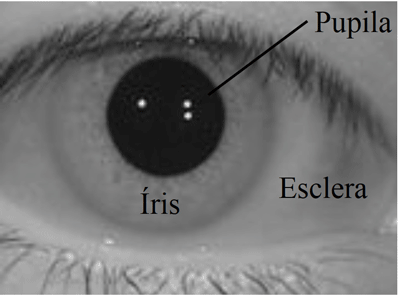- Biometrics represents studies related to some human characteristics that can be used in distinguishing two distinct persons. Currently, there are many characteristics used as biometrics in real-world applications. The most commonly used include biometrics, face, hand veins, fingerprints, hand geometry, Iris, palm prints, voice patterns.
- biometrics are considered as highly secure for identification of individuals as they are distinctive. Furthermore, it is extremely difficult to be forged. Moreover, biometrics are very convenient in their usage because they can not be stolen or forgotten somewhere. The main usage of biometrics within smart projects is mainly related to data access control, i.e. through the checking of biometrics, some user can be granted or denied access to the protected service or information. It is a general belief that the usage of biometrics is the perfect solution for all identification problems.
- The Iris has a texture, which is randomly determined in the embryonic stage, as well as fingerprints. Iris textures have been used as a human identifier for some time now. They are considered one of the most reliable ways to distinguish a human from another. It is considered one of the most reliable because it is an internal and practically invariant organ for a lifetime. It is a flat organ and its diameter changes only with the contraction and dilation of the pupil. It is actually a recent biometrics, and it is already being used in various security systems around the world, as the United Arab Emirates, Amsterdam Airport Schiphol, Canadian Air Transport Security Authority, among many others. Market researchers have predicted biometric smartphones will reach 100% adoption by 2020, and recent Samsung smartphone Galaxy Note 7 is already featuring Iris recognition to market.

- Above image shows the parts of the eye that need to be considered when comparing Irises. Another benefit of Iris biometrics usage is the distance of capture, making the touch of the reading equipment not necessary. Most equipment operates from 10cm till few meters. However, this brings a difficulty for the verification of biometrics. This distance, which on one hand, is comfortable results in an image that requires some processing before obtaining the Iris template. This process usually results in error during the matching process. Another source of error comes from the number of obstacles that may prevent the correct capture of the Iris as the eyelids and eyelashes. Since it may be possible to detect with Iris by mistake A group of students with names Nedjah, R. S. Wyant, L. M. Mourelle and B. B. Gupta from State University of Rio de Janeiro, Brazil Department of Computer Engineering, In 2017, they presented an article in which biometric details of the Iris are recorded on unique smart cards and the matching of individuals when they are identified and processed by it.
Palizafzar corp with the experience of more than 20 years, honored the best devices access control and attendance online facial recognition and fingerprints all over Iran to supply our compatriots.
Wednesday, March 14, 2018
Biometric Iris Recognition
Subscribe to:
Comments (Atom)